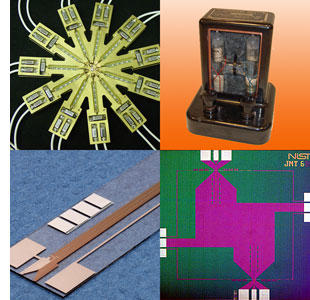History of NIST Quantum Voltage Standards
Celebrating the 100th Anniversary of the Discovery of Superconductivity

Superconductivity is the ability of certain materials to conduct electricity without resistance when cooled below a specific temperature. Superconductivity was first discovered on April 8, 1911, by the Dutch physicist Heike Kamerlingh Onnes. He observed superconductivity in mercury at 4.2 K (minus 269 C/minus 452 F). Many other superconducting materials have been discovered since then.
Superconductivity is a quantum phenomenon, featuring regular and predictable units of energy, which makes it useful for precision measurements. Superconductivity has many practical applications, including quantum voltage standards. Voltage standards may be the most successful practical electronics application of superconductivity based on numbers of devices in worldwide use.
Over four decades, the National Institute of Standards and Technology (NIST)* has developed a series of voltage standards based on superconducting Josephson junctions. The standards are used worldwide by industry, government and military laboratories to calibrate voltmeters—common instruments for applications ranging from the electric power grid to consumer electronics to advanced military equipment. Every standard is based on quantum mechanics, which ensures that the voltage does not drift with time or due to environmental conditions. Many artifacts described below are on exhibit at NIST's Boulder, Colo., campus. Technology advances over the decades are evident in the materials and packaging, junction numbers and arrangements, and voltage magnitude and production methods.
* NIST was called the National Bureau of Standards until 1988.
Explore the History of NIST Quantum Voltage Standards

